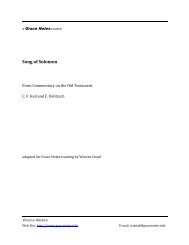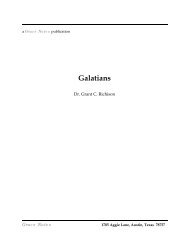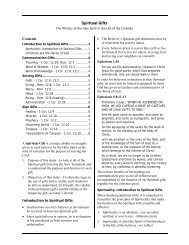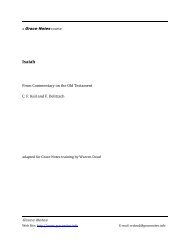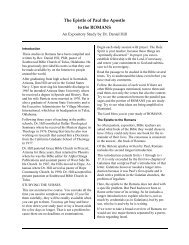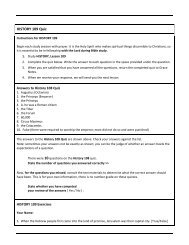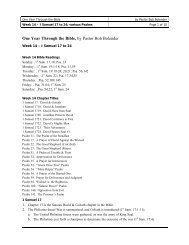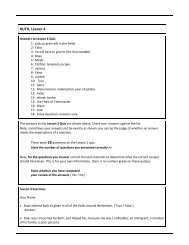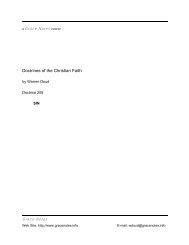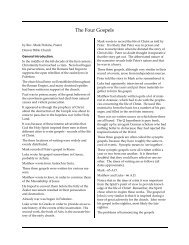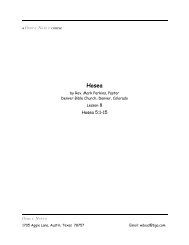Create successful ePaper yourself
Turn your PDF publications into a flip-book with our unique Google optimized e-Paper software.
<strong>Apostolic</strong> <strong>Fathers</strong> 12Pauline letters) and to 1 Clement. Polycarpcommends the Philippians for their faith andendurance, and summons them to continue inthe service of God (chs 1f). He speaks to them ofrighteousness at their invitation, though hedeclines to compare himself with “the blessedand glorious Paul” who had taught the word oftruth and written letters to them. In the Paulinetradition, Polycarp sees righteousness ascoming through faith, hope, and love (ch 3). Hesets forth the duties of groups in the church,husbands, wives, widows, deacons, youngermen, and presbyters (chs 4–6; no bishop ismentioned). He then warns against heresy interms reminiscent of John: “Everyone who doesnot confess that Jesus Christ has come in theflesh is an anti-Christ” (7:1; cf. 1 Jn. 4:2f; 2 Jn. 7).In the face of denials of resurrection andjudgment, the Church must return to thetradition it received in the beginning (7:2), andimitate the endurance of Christ and the martyrs(chs 8f). Christian believers are to love eachother and give alms (ch 10), avoiding the greedthat has led some astray (e.g., a certainpresbyter named Valens, 11:1–12:1). Polycarpcloses the epistle with a benediction, an appealto pray for fellow Christians and for rulers,some final remarks about Ignatius and hisletters, and a word of recommendation for themessenger who will bring the epistles toPhilippi (12:2–14:1).If any one theme can be singled out, it isexpressed by the phrase “concerningrighteousness” in 3:1 (cf. 3:3; 4:1; 8:1; 9:1f).Though Polycarp connects this theme withPaul, he develops it not in the Pauline sense butin terms of rather conventional exhortations tovirtue and faithfulness. He is more concerned topreserve and hand down traditions ofgenerally-accepted Christian truth than toshape or adapt them to particular needs orsituations, much less to move out in any newdirections. Polycarp’s epistle is of more interestfor its sources than for itself.VII. Martyrdom of PolycarpThis most ancient of Christian martyr accountstakes the form of a letter from the church ofSmyrna to the church of Philomelium inPhrygia, and beyond that church “to all theparishes of the holy universal church in everyplace” (Mart. Polyc, inscr; cf. 20:1 and 1 Cor.1:1). It gives every evidence of being what itclaims to be, an eyewitness report (15:1),apparently written within a year of the event itdescribes (18:3).<strong>The</strong> Martyrdom of Polycarp is known in sixGreek MSS, in extensive quotations by Eusebius(HE iv.l5) and a Latin version (Armenian,Syriac, and Coptic versions are simply based onEusebius). <strong>The</strong> most reliable Greek witness isgenerally considered to be the so-calledMoscow MS. Several appendices volunteerinformation about the Martyrdom’stransmission: a certain Gaius claims to havecopied it from papers belonging to Irenaeus (adisciple of Polycarp), and at a later time acertain Pionius claims to have transcribed itfrom a copy whose location was revealed tohim by “the blessed Polycarp” himself in avision (22:2f). Another conclusion, found onlyin the Moscow MS, seems to attribute the actualwriting of the Martyrdom to Irenaeus and goesto great lengths to emphasize the closeconnection of Irenaeus with Polycarp. (At theexact moment when Polycarp died in Smyrna,Irenaeus heard a voice in Rome saying,“Polycarp has been martyred”!) Such traditionsseem to be shaped by a desire to reinforce thelinks between the orthodox fathers and theapostles. Though the reference to Gaius maywell be authentic, much of the rest is open toserious question. Still another appendix (21:1)offers an exact date for the martyrdom (Feb. 23,155, or Feb. 22, 156, according to differentmethods of reckoning), which disagrees withthe date of 166/167 fixed by Eusebius in hisChronicon. <strong>The</strong> ruling officials mentioned in21:1 and 12:2 suggest in any case a date before160. But in general the epistle itself carriesmore marks of its own authenticity than do theappendices which were written to validate it.<strong>The</strong> writer introduces his narrative as a“martyrdom in accord with the Gospel” (1:1),and prefaces the actual story of Polycarp with afew briefer accounts of those who had justpreviously suffered for Christ (2:1–4:2). Hemakes the point that to give oneself upvoluntarily or to seek martyrdom is not inaccordance with the teaching of the gospel



